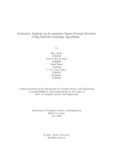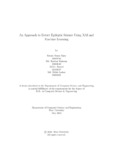Sentiment analysis on E-commerce based product reviews using machine learning algorithms
Abstract
Opinions from others can be important when a choice is necessary, mainly when
valuable resources such as time and wealth are involved. People often depend on
their peers’ past experiences. The analysis of sentiments or opinions is a computation
using text analysis of people’s emotions, thoughts, and feelings. In recent years, it
became the most significant natural language processing and sentiment analysis
research approach. Because it is founded on people’s views and as all people have
different viewpoints to see things, it is becoming more popular every day. In this
digital world, when a person decides to purchase a product or utilize a service, they
get access to many customer evaluations. Still, it is a tiresome process to read
and analyze them all. Moreover, when an organization wants to make a profit,
find new possibilities, anticipate sales trends, and manage its reputation via public
opinion or sell its product, it also needs to address many customer remarks accessible
to its customers. Therefore, our goal is to show that it is feasible to do so with
sentiment analysis approaches. With sentiment analysis, it is easy to analyze and
extract a vast number of accessible data comments from both consumers that can
aid in fulfilling the objectives of the organization. The dataset utilized here is
obtained from the Ali-Express e-commerce website’s online product reviews. We
use various data processing techniques such as tokenization, removal of punctuation
marks and stop words, stemming, TF-IDF, and parts of speech tagging. The results
of our study comprise several methods of machine learning techniques. In this
work, we examined eight distinct types of Machine Learning Algorithms, including
Naive Bayes Classifier, SVM, Random Forest Classifier, Logistic Regression (L.R.),
K- nearest neighbors, XGBoost Classifier, Decision Tree Classifier, and Gradient
Boosting, and compared their precision and accuracy to find the most accurate one.
According to our analysis, Logistic Regression is performing better among all the
other seven classifiers having an accuracy of around 98%, and KNN is performing
lowest, having an accuracy of 46%. Other classifiers such as Decision Tree is, giving
69%, Gradient Boosting 63%, Naive Bayes and SVM 82%, and Random Forest and
XGBoost are giving 80% of accuracy.
Keywords
Tokenization; Naive Bayes Classifier; SVM; Random Forest Classifier; Logistic Regression (L.R.); K-nearest neighbors; XGBoost classifier; Decision Tree Classifier(DTC); Gradient boosting classifier; TF-IDFDescription
This thesis is submitted in partial fulfillment of the requirements for the degree of Bachelor of Science in Computer Science, 2022.Department
Department of Computer Science and Engineering, Brac UniversityType
ThesisCollections
Related items
Showing items related by title, author, creator and subject.
-
Detection of mental stress using EEG signal and classifier based on reward and punishment processing
Salim, Farhana Binta; Sadat, Abu Md.; Ema, Maria Islam; Jhara, Anita Mahmud (Brac University, 2021-01)Mental stress is the main well being problem worldwide today. Mental stress is by far the most common, responsible for most of all mental-brain diseases. The high incidence, high impairment and heavy risk of illness make ... -
An approach to detect epileptic seizure using XAI and machine learning
Bijoy, Emam Hasan; Rahman, Md. Hasibur; Ahmed, Sabbir; Laskor, Md. Shifat (Brac University, 2022-05)One of the most common neurological disorder in health sector is Epileptic Seizure (ES) which is occurred by sudden repeated seizures. Hitherto more than 50 million people in the whole world are suffering from Epileptic ... -
Flood prediction using machine learning models
Syeed, Miah Mohammad Asif; Farzana, Maisha; Namir, Ishadie; Ishrar, Ipshita; Nushra, Meherin Hossain (Brac University, 2022-01)Floods are one of nature’s most catastrophic calamities which cause irreversible and immense damage to human life, agriculture, infrastructure and socio-economic system. Floods are one of Bangladesh’s most common natural ...




